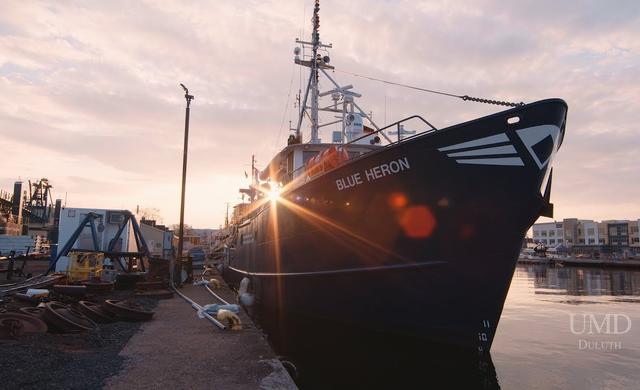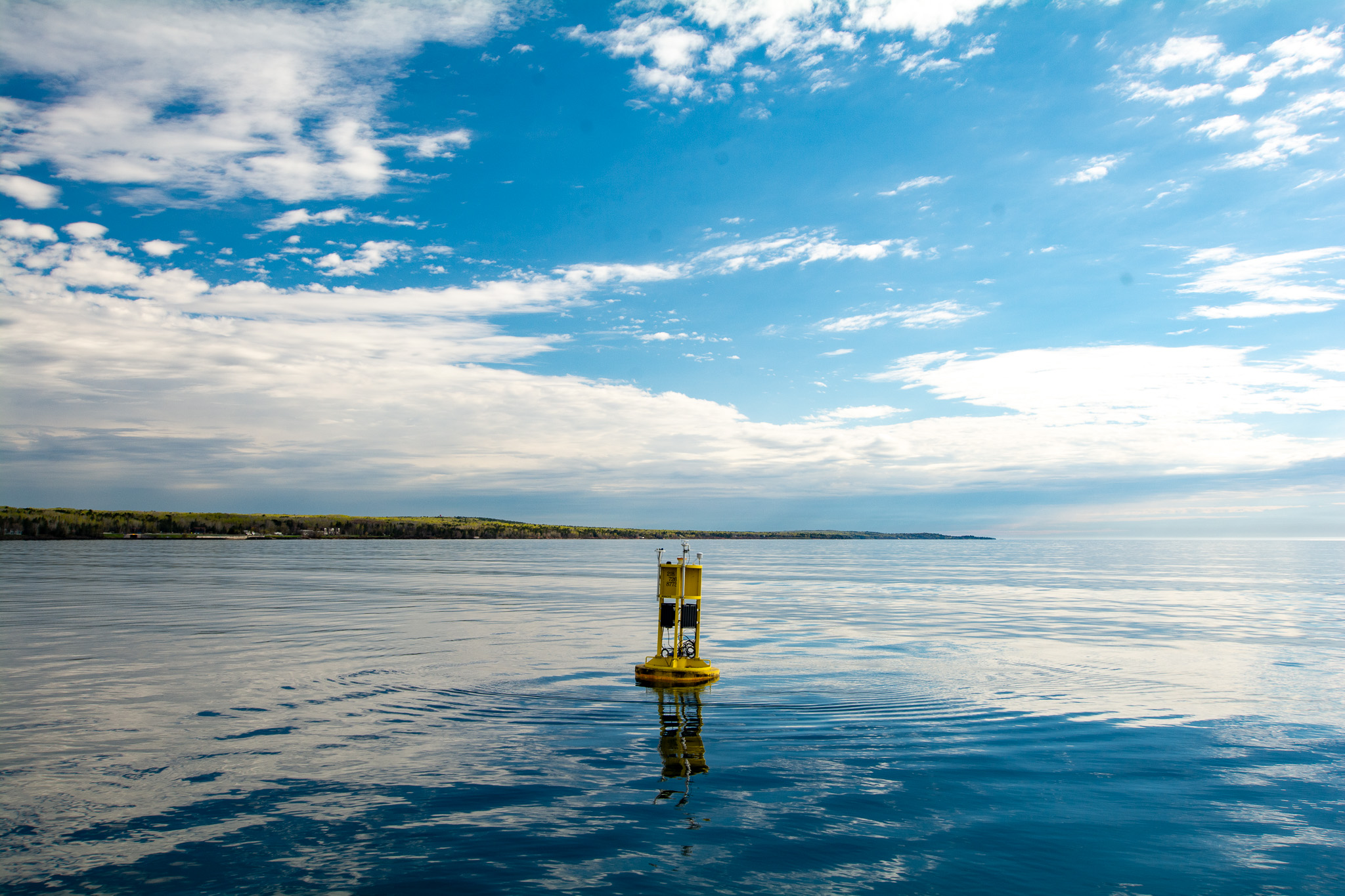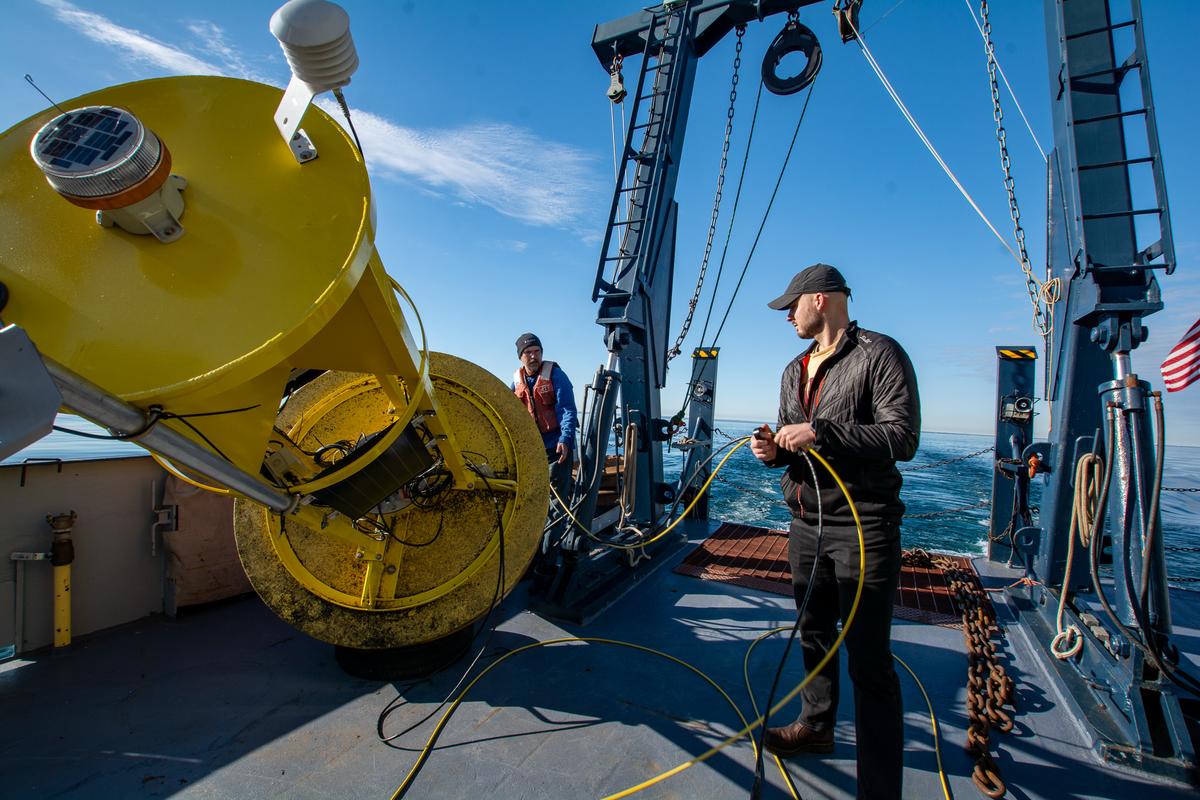Jay Austin and members of his research team on R/V Blue Heron prep a meteorological buoy for deployment in western Lake Superior. Image credit: Cait Dettmann/MNSG.
Duluth, Minn. — For over 11 years Jay Austin and his research team at the University of Minnesota Duluth (UMD) have carefully tended to a crop of bright-yellow meteorological buoys floating on Lake Superior. Each buoy captures real-time data used for weather forecasting, marine safety, commercial fishing charters, paddlers, swimmers, boaters, researchers and by anyone curious about the largest of the Great Lakes.
“We want to understand how the lake and the atmosphere above it interact,” said Austin, a physical limnologist (lake scientist) and professor of physics and astronomy at UMD. “Specifically, we want to understand how that interaction impacts the lake, and how it is changing over time.”
In May 2024, Minnesota Sea Grant (MNSG) joined Austin and his team to video their deployment of two buoys from the R/V Blue Heron. Their voyage was in the waters of Lake Superior near Duluth and was part of Austin’s MNSG-funded research project “Extending and Improving Observational Capacity on Lake Superior’s Minnesota North Shore.”
Despite the name, meteorological buoys collect more than just weather data. And Austin’s buoys aren’t just collecting data from above the surface of the water.
Austin’s buoys sit about 8 feet above the water’s surface. Each buoy is powered by a marine battery and a solar panel and each carries several sensors. The buoys themselves, each composed of a steel frame sitting atop a foam hull, are ordered from a buoy vendor, ready for Austin and his team to affix necessary equipment.
The surface buoys are anchored to the lake bed with steel cables that are each attached to a 2,000-pound railcar wheel in about 160 feet of water. Each buoy gets a unique five-digit number assigned by the National Data Buoy Center (NDBC), a nationwide repository of ocean and large lake data. Austin’s buoys are LLO3 (#45027), LLO4 (#45028) and LLO5 (#45219).
LLO3 floats in the vicinity of the water intake for Duluth’s Lakewood Water Treatment Plant, several miles east of the Lester River, while LLO4 is anchored to the southeast and further from the coast to better capture offshore conditions. Austin and his team are very careful to not place buoys in shipping lanes. This helps to avoid conflicts with the millions of tons of cargo that move in and out of the Port of Duluth-Superior.
The above-water sensors measure air temperature, humidity, wind speed and direction, solar radiation, and wave height. The below-water sensors collect data about water temperature at depths of 3, 5, and 10 meters (10, 16, and 33 feet) beneath the surface, and continue at 5-meter (16-foot) increments to the lakebed.
Additional sensors capture biogeochemical parameters such as chlorophyll fluorescence that can be used to detect algal blooms.

Useful information for anglers and swimmers
Anglers are particularly interested in knowing the temperature of water at varying depths as it affects where different fish can be found, their activity levels, and how easy (or not) they are to catch.
Subsurface temperature sensors on the buoys enable the research team to better understand aquatic phenomena such as upwelling, which is a process by which offshore winds push surface water away from the shore, which then allows cold lake water to rise up to the surface from beneath. Upwelling can cause the surface temperature of lake water to drop from a swimmable or paddleable 70 degrees F to a life-threatening and hypothermia-inducing 50 degrees F in only an hour.
Austin’s team deployed a third buoy (LLO5 #45219) in July 2024 near Two Harbors, Minnesota, at the request of the National Weather Service. This buoy is a scaled-down version of the LLO3 and LLO4 buoys and was funded in part by the National Oceanic and Atmospheric Administration’s Great Lakes Observing System (GLOS).
Surface buoys operate during the ice-free months of the year, generally being deployed in mid to late spring, before being recovered by Austin’s team in mid to late fall.
“Winter is sort of a Holy Grail,” Austin said. “There’s a gap in seasonal knowledge.”
The knowledge gap results from being unable to use above-surface buoys during the winter months, as they are likely to be damaged by ice and there’s insufficient solar activity needed to power the data-collecting sensors.
Austin has a winter solution
When Austin’s team recovers the buoys in the fall, they will deploy an over-winter mooring with multiple temperature sensors. Unlike the surface buoys, the over-winter mooring bobs about 10 meters below the water’s surface and can collect data through the winter.
Data from the surface buoys are transmitted to Austin’s lab at UMD every 10 minutes, using what is essentially a cell phone on each buoy. The data is quality checked and then sent to the National Data Buoy Center, Great Lakes Observing System and posted to the project website.
Unusual observations
To Austin, who has tended to these big buoys for over a decade, the most unusual data has been Lake Superior surface temperatures in the range of 70 degrees F. The lake has warmed one degree per decade since the 1980s, making it one of the fastest-warming lakes in the world.
Thanks to the solar radiation sensors aboard the buoys, Austin has been able to indirectly watch solar eclipses through observing the pronounced dip in solar radiation.
Warmer surface water temperatures might be welcomed by swimmers, but a warming Lake Superior can contribute to summertime blue-green algal blooms, which scientists first observed on the lake in 2012.
These blooms tend to occur in years when the water is warm, with Lake Superior’s largest blooms occurring in 2012 and 2018 after large storms.
"As conditions in Lake Superior continue to change as a result of climate change, strains of toxic cyanobacteria or blue-green algae may become established in Lake Superior along the shoreline near popular destinations,” said Chris Filstrup, an applied limnologist and director of the Central Analytical Lab of UMD’s Natural Resources Research Institute.
Filstrup noted that the dominant cyanobacteria strains in Lake Superior can't produce toxins with known health implications, but said recent reports of detectable toxin concentrations in the St. Louis River Estuary suggest the possibility of toxic blooms in Lake Superior in the future.
So after tending to buoys for over a decade, what excites Austin most about this latest project extension? “Continuity,” he said. Each year of research yields a bumper crop of data that can help researchers and resource managers better understand change in the Great Lakes over time.

ADDITIONAL INFORMATION
Support for this project is provided by Minnesota Sea Grant’s 2024-2026 Biennial Request for Proposal program. Every two years MNSG awards approximately $2 million in research grants through a rigorous, competitive, peer-reviewed process. Researchers based in Minnesota, who are not federal employees, are invited to apply. Grant awards average about $45,000 per year for two years, plus a graduate research associate whose cost does not count against the project budget.
Minnesota Sea Grant is a systemwide program of the University of Minnesota and one of 34 Sea Grant federal-university partnerships across the country that bring applied water science to communities. MNSG has staff and offices on the Duluth and St. Paul campuses. Our extension educators, researchers, and communicators work with community members, local decision-makers, policy leaders, and personnel from resource agencies, business, and industry to enhance the use and conservation of Great Lakes and Minnesota’s inland water resources to create strong and sustainable economies, healthy environments, and resilient and inclusive communities.
CONTACTS:
Jay Austin, professor, Large Lakes Observatory and Department of Physics and Astronomy, University of Minnesota Duluth. jaustin@d.umn.edu
Amanda Shie, communications associate, Minnesota Sea Grant, University of Minnesota and University of Minnesota Duluth. shie0093@umn.edu
Marie Thoms, communications manager, Minnesota Sea Grant, University of Minnesota and University of Minnesota Duluth. methoms@d.umn.edu
AVAILABILITY:
Jay Austin can best be reached via email during weekdays.
